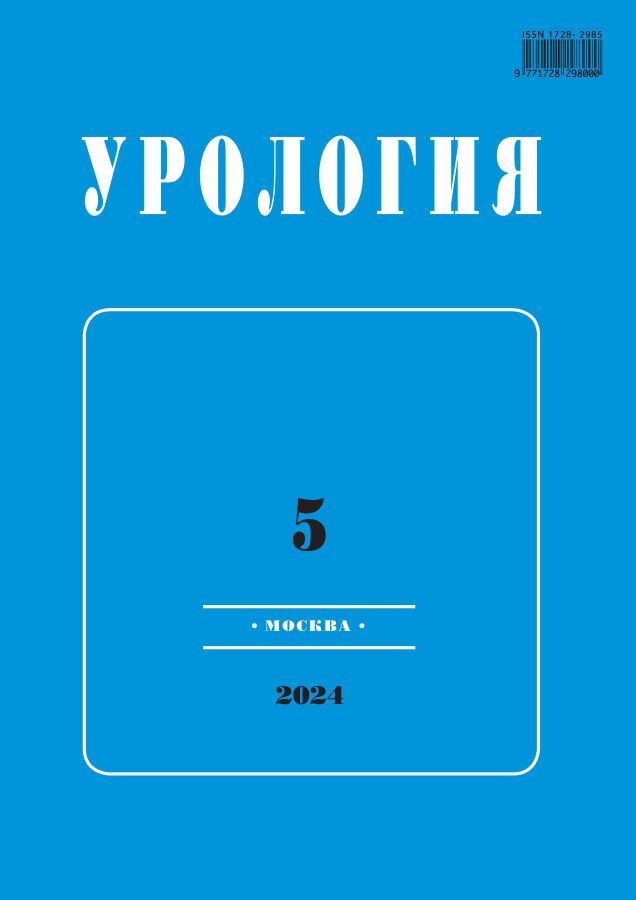The TG/HDL ratio as a marker of dyslipidemia among patients on maintenance hemodialysis. A cross-sectional study
- Authors: Hayder A.1, Zaid D.1, Sara H.1, Zainab A.1, Zinelabidin S.1
-
Affiliations:
- University of Basrah
- Issue: No 5 (2024)
- Pages: 97-101
- Section: Uronephrology
- URL: https://journals.eco-vector.com/1728-2985/article/view/642279
- DOI: https://doi.org/10.18565/urology.2024.5.97-101
- ID: 642279
Cite item
Abstract
Background and objectives: Dyslipidemia is prevalent among patients with chronic kidney disease on maintenance hemodialysis. A high LDL is a known indicator of major adverse cardiovascular outcomes, but levels may be affected by malnutrition. A high TG/HDL ratio is another indicator of hard cardiovascular outcomes that should be sought carefully.
Patients and Methods: This was a cross-sectional study conducted on 111 patients on maintenance hemodialysis attending the hemodialysis unit at Basrah Nephrology and Transplantation Center at Al-Sader Teaching Hospital from September 1, 2022, to March 1, 2023. A high LDL is defined as > 60 mg/dl, and a high TG/HDL ratio is defined as >2.
Results: Among 111 patients with CKD on maintenance hemodialysis, high LDL was prevalent in 59.1%, and high TG/HDL ratio in 64.5%. Their mean ages were 52.6±15.7 years, 51.4% were males, and their BMIs were 25.2±5.6. Thirty-nine patients (35.1%) were on Aspirin (ASA), 49 patients (44.1%) were on Statins, eight patients (7.2%) were on Fibrate, and 11 patients (9.9%) were on Omega-3 fatty acids. No correlations were found between serum LDL and serum TG/HDL ratio with clinical and laboratory characteristics. A non-linear correlation between serum LDL and TG/HDL ratio was reported.
Conclusions: A high TG/HDL ratio should be sought and addressed carefully among patients with CKD on maintenance hemodialysis, as low LDL may be misleading in those populations.
Keywords
Full Text
About the authors
Aledan Hayder
University of Basrah
Author for correspondence.
Email: Hayder.aledan@uobasrah.edu.iq
ORCID iD: 0000-0002-5938-1421
MD, FASN, College of Medicine, Department of Medicine, Division of Nephrology
Iraq, BasrahDavid Zaid
University of Basrah
Email: zaid.david.med1718a@bjes.edu.iq
Students, College of Medicine
Iraq, BasrahHaider Sara
University of Basrah
Email: sarah.haider.med1718a@bjes.edu.iq
Students, College of Medicine
Iraq, BasrahAlmosawi Zainab
University of Basrah
Email: zeinab.iyad.med1718a@bjes.edu.iq
Students, College of Medicine
Iraq, BasrahSaleh Zinelabidin
University of Basrah
Email: zain.al-abideen.ali.med1718a@bjes.edu.iq
Students, College of Medicine
Iraq, BasrahReferences
- Hill NR, Fatoba ST, Oke JL, Hirst JA, O’Callaghan CA, Lasserson DS, et al. Global Prevalence of Chronic Kidney Disease - A Systematic Review and Meta-Analysis. PloS One. 2016;11(7):e0158765.
- Mesquita J, Varela A, Medina JL. Dyslipidemia in renal disease: causes, consequences and treatment. Endocrinol Nutr Organo Soc Espanola Endocrinol Nutr. 2010;57(9):440–8.
- Lee C, Park JT, Chang TI, Kang EW, Nam KH, Joo YS, et al. Low-density lipoprotein cholesterol levels and adverse clinical outcomes in chronic kidney disease: Results from the KNOW-CKD. Nutr Metab Cardiovasc Dis. 2022;32(2):410–9.
- Gluba-Brzozka A, Franczyk B, Rysz J. Cholesterol Disturbances and the Role of Proper Nutrition in CKD Patients. Nutrients. 2019;11(11):2820.
- Lv S, Zhang H, Chen J, Shen Z, Zhu C, Gu Y, et al. The effect of triglycerides to high-density lipoprotein cholesterol ratio on the reduction of renal function: findings from China health and retirement longitudinal study (CHARLS). Lipids Health Dis. 2021;20:110.
- da Luz PL, Favarato D, Faria-Neto JR, Lemos P, Chagas ACP. High ratio of triglycerides to HDL-cholesterol predicts extensive coronary disease. Clin Sao Paulo Braz. 2008;63(4):427–32.
- Pontremoli R, Bellizzi V, Bianchi S, Bigazzi R, Cernaro V, Del Vecchio L, et al. Management of dyslipidaemia in patients with chronic kidney disease: a position paper endorsed by the Italian Society of Nephrology. J Nephrol. 2020;33(3):417–30.
- Kim Y, Lee S, Lee Y, Kang MW, Park S, Park S, et al. Predictive value of triglyceride/high-density lipoprotein cholesterol for major clinical outcomes in advanced chronic kidney disease: a nationwide population-based study. Clin Kidney J. 2020;14(8):1961–8.
- Hajian-Tilaki K, Heidari B, Bakhtiari A. Triglyceride to high-density lipoprotein cholesterol and low-density lipoprotein cholestrol to high-density lipoprotein cholesterol ratios are predictors of cardiovascular risk in Iranian adults: Evidence from a population-based cross-sectional study. Casp J Intern Med. 2020;11(1):53–61.
- Makówka A, Dryja P, Chwatko G, Bald E, Nowicki M. Treatment of chronic hemodialysis patients with low-dose fenofibrate effectively reduces plasma lipids and affects plasma redox status. Lipids Health Dis. 2012;11:47.
- Fazelian S, Moradi F, Agah S, Hoseini A, Heydari H, Morvaridzadeh M, et al. Effect of omega-3 fatty acids supplementation on cardio-metabolic and oxidative stress parameters in patients with chronic kidney disease: a systematic review and meta-analysis. BMC Nephrol. 2021;22:160.
- Lipid metabolism disorders and bone dysfunction-interrelated and mutually regulated (Review) - PMC [Internet]. [cited 2023 May 13]. Available from: https://www.ncbi.nlm.nih.gov/pmc/articles/PMC4438959/
Supplementary files










